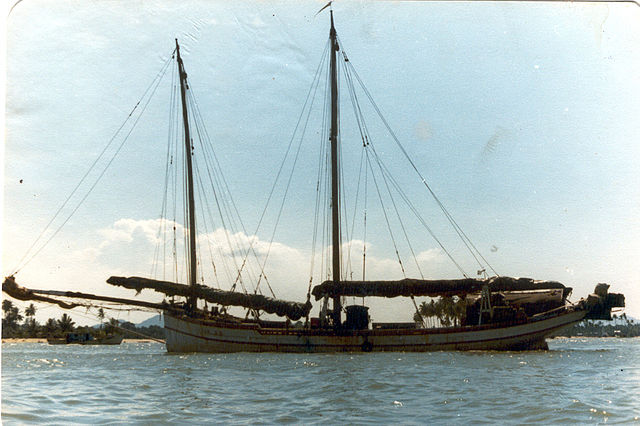The pinas, sometimes called "pinis" as well, is a type of schooner of the east coast of the Malay peninsula, built in the Terengganu area. This kind of vessel was built of Chengal wood by the Malays since the 19th century and roamed the South China Sea and adjacent oceans as one of the two types of traditional sailing vessels the late Malay maritime culture has developed: The bedar and the pinas.
The original pinas was rigged with European fore-and-aft rig.
The pinas Sabar, (26.5 m LOD), the last original sailing pinas of Kuala Terengganu, 1980
The pinas Sabar in the museum of Kuala Terengganu, 1998
The Naga Pelangi, a 22 m (LOD) pinas built in 2009 on Pulau Duyong, sailing in Langkawi 2010
The term bedar is applied to a wide variety of boats of the east coast of Malaysia that carry one or two junk sails and lack the typical transom stern of the perahu pinas. These junk rigged boats are usually built in the Terengganu area. The stern of the bedar is a classical "canu" or "pinky stern," being a typical "double ender", a bit like a modern ship's lifeboat, with a very full turn of the bilge and with markedly raked stem and stern. They came in small versions as small one-masted fishing vessels — anak bedar and were built as big as 90 feet over deck (LOD). The majority of the bedars were usually 45 to 60 feet over deck. The bedar, like all Terengganu boats, was built of Chengal wood by the Malays since the 19th century and roamed the South China Sea and adjacent oceans as a highly seaworthy traditional sailing vessel.
The original Naga Pelangi, a bedar built in 1981, sailing off Singapore
The last big sailing bedar, Dapat, (87' / 26.5 m LOD) anchored in Kuala Terengganu in 1980
The bedar Dapat unloaded in the estuary of Kuala Terengganu, 1980
Che Ali bin Ngah building the bedar Naga Pelangi on Pulau Duyong, Kuala Terengganu, 1981








